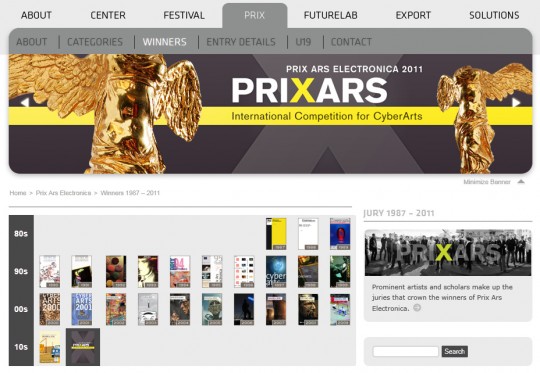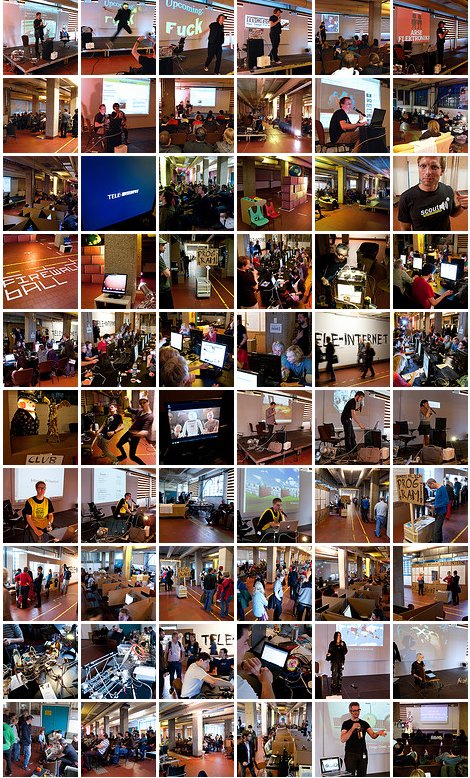Archive for the ‘ars electronica’ tag
Dead Drops: Honorary Mention – Prix Ars Electronica
I am very pleased to announce that Dead Drops won an Honorary Mention at Prix Ars Electronica 2011!
TELE-INTERNET video
TELE-INTERNET from Aram Bartholl on Vimeo.
more documentation on http://datenform.de/teleinternet/documentation/
TELE-INTERNET pics
#TELEINTERNET bit.ly/teleinternet at Ars Electronica last weekend was awesome! Thanks to everyone for participating and thx to the As team for support! Most popular ‘piece’ in the show was our coinopperated coffee machine :-)
Stay tuned for more documentation …
TELE-INTERNET – The 2010 Ars Electronica Internet Shop!
“TELE-INTERNET is an organically growing structure, a hacker space, an (un)conference, a stage, an exhibition, a social performance, Commune 0/1, and a site for anyone who’s interested in discussing the development of the internet, exchanging ideas, and presenting their own projects. Ars Electronica festivalgoers are invited to take the plunge and join the fun, to contribute to the discussion, or to chill out on the couch with a clubmate and a notebook.”
curated by Aram Bartholl , 2010
This event will take place at the media art festival Ars Electronica, Linz, Austria, 2nd-6th of September 2010. TELE-INTERNETrepresents the Prix Ars Electronica category ‘Digital Communities’ of which the CCC – Chaos Computer Club won the 1st prize Golden Nica 2010. The TELE-INTERNET program includes talks, presentations, discussions, panels, work in progress, projects, pop, performance, meetings, art, workshops, screenings and much more. Get full info on the program and on all participants atbit.ly/teleinternet and follow us on http://twitter.com/teleinternet #teleinternet
OPEN CALL: If you happen to be at Ars in September and you were interested to give a lightning talk or to squad a table with your project please get in touch with the TELE-INTERNET team.
TELE-INTERNET curated by Aram Bartholl at Ars Electronica, Linz, Austria, 2nd-6th of September 2010
Participants:
- *Map Kibera*: Mikel Maron (US) http://mapkibera.org [award of distinction]
- *#unibrennt cloud*: institute for science and technology ars (ISTA) of unibrennt (AT) with http://unibrennt.tvhttp://unsereuni.at [award of distinction]
- *CBA – Cultural Broadcasting Archive*: Ingo Leindecker (AT) , Thomas Diesenreiter (DE), http://cba.fro.at [honorable mention]
- *MakerBot Industries*: Bre Pettis (US); http://makerbot.com [honorable mention]
- *The Tor Project*: Anonymity online, Andreas Lehner (DE) https://torproject.org [honorable mention]
- *Web2.0 suicide machine*: moddr_ [Walter Langelaar (NL), Gordan Savicic (AT), Danja Vasiliev (RU)]; http://moddr.net[honorable mention]
- *A Golden Era – making and unmaking of Piratbyrån*: Golden bus + archive (SE) 2003-2010 http://piratbyran.se
- *Arse Electronica*: talk, monochrom / Johannes Grenzfurthner (AT); http://www.monochrom.at/arse-elektronika/
- *Artzilla*: Skate the web! workshops and contests, Tobias Leingruber (DE); 2010 http://artzilla.org
- *DIASPORA*: Maxwell Salzberg (US) http://joindiaspora.com
- *Digital Folklore*: Olia Lialina (RU) & Dragan Espenschied (DE); 2009 http://digital-folklore.org
- *F.A.T. Lab*: Free Art & Technology Lab: Cloud services, Jamie Wilkinson, 2010 http://fffff.at
- *Firewall Ball*: Johannes P Osterhoff (DE) 2010 http://johannes-p-osterhoff.com
- *flattr*: social micropayment platform, Peter Sunde (SE) http://flattr.com
- *Metalab Squad of Awesome*: official delegation from the Viennese hackerspace (AT) http://metalab.at
- *My last Ars*: live gif mashup – VJ set, Evan Roth (US) 2010 http://evan-roth.com
- *OpenActa / AFI*: Geraldine Juarez (MX) a-f-i.tumblr.com http://www.openacta.org
- *Star Wars Uncut*: the movie, Casey Pugh, http://starwarsuncut.com/
- *superbertram*: Georg Schütz (AT) 2007-2010 http://superbertram.com
- *Telecomix*: A sociocyphernetic jellyfish cluster, (SE) http://telecomix.org
- *Thumbing & FolkSomy.vj*: JODI (NL/BE); 2010 http://thumbing.org http://folksomy.net
- *Trail Blazers*: Theo Seemann & Beautiful Zeros and Ugly Ones, Merz Akademie(DE); 2010 http://nm.merz-akademie.de/trailblazers
- *BOSCO-Uganda*, *ceibalJAM!*, *CulturaDigital.Br*, *FixMyStreet*, *Kloop*, *Puncar Action!*, *Sourcemap*, *TEDtoChina*, (honorable mentions of Digital Communities)
- and more and more and more ….
"A new cultural economy" and Watering Cans
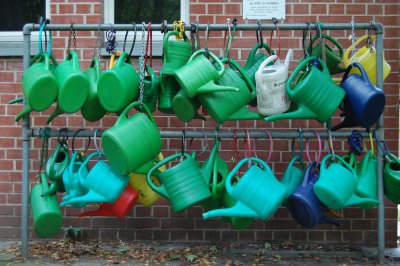
“A new cultural economy” was the title of the symposium curated by Joichi Ito at Ars Electronica a week ago. I enjoyed a lot the brillant speakers most of them from the US and Jonah did write a good abstract on the presentations for Rhizome.
Buzz word collection: Intellectual property, copyright, creative commons, sience commons, GPL, open source, closed, amateur, creativity, remixing, sharing, crowd sourcing/computing, citizen journalism, lost authority, chaos, noise, truth, fear ….. and again and again the big examples: Music, Film and Wikipedia.
Sure we are talking about cultural economy and the example of the music economy development in last decade or the success of Wikipedia shows very well what’s going on. But in retrospective I ‘ve been missing some crucial questions:
– How will/can this whole development affect economy in general?
– What is the role of DIY (Do it yourself) and the free instructions culture development?
– In wich way will physical objcts/products be involved? (Just think of the upcoming rapid prototyping era.)
– Are we only talking about cultural/intellectual property?
– Is there a reason to wait for companies to come up with great new products like a green car, alternative energy sources or just day to day life simplicity?
– Where is the DIY mobile medicin prototyping lab kit for the 3rd world? And will medical industry do the same faults like spoiled music people?
Podcasts of all talks
Unfortunately there are no videos, but I can recommend the talk of Yochai Benkler.
Picture:
Watering cans on a graveyard in Berlin. Instead of having a few public cans everybody has its own one looked to a stand. A very good symbol on a current mindset of property in society. (with a maybe typical german twist.)
L’Homme au Chapeau Melon

The Image Fulgurator by Julius von Bismarck (winner of a Golden Nica) was of course my favorite piece at Ars Electronica. In addition to the groundbreaking idea he did a really good job in documenting his latest interventions for the Cyberarts show at Ars Electronica. Besides a crucifix he added to Obamas speakers desk during the Berlin speech he traveled to Beijing and manipulated the most symbolic place of official China. He projected a pigeon related to the Magritte’s painting “L’Homme au Chapeau Melon” on top of Mao’s face which was then only visible to chinese tourists with digi cams. Wow! A very good way of showing the Image Fulgurator’s power. I hope that he will release that beautiful video documentation online.
Apeel
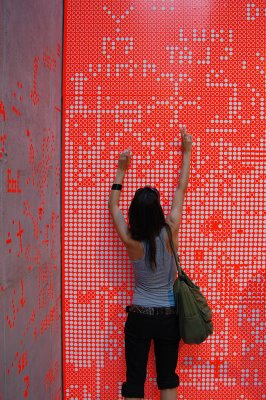
A very simple, again paper based and fun interactive project by Richard The » Gunnar Green » Frédéric Eyl » Willy Sengewald got an honary mention and was exhibited at Ars Electronica this year. It reminded me of a picture of an ‘interactive’ facade I posted a while ago.
Appeel is a virus spreading through interacting individuals. Surfaces are covered by thousands of colored stickers laid out in a grid. Peeling a sticker off leaves a white spot in the grid, hence people start individually and collectively changing its appearance. Once off the wall, the stickers ask to be stuck somewhere: people begin putting them on objects, walls, people; they collect them, they compose new images, they write messages. Slowly, the little stickers spread, appearing further away from their source and occupying space.
Prix Ars Electronica 2008, Honorary Mention Interactive Art
Image Fulgurator
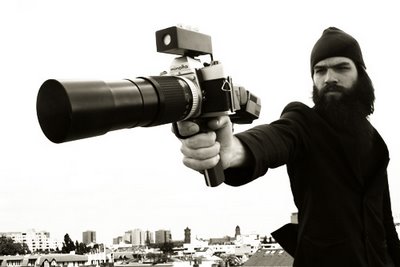
Ars Electronica announced golden nica winners for 2008! In the category INTERACTIVE ART Julius von Bismarck got a golden nica for the Image Fulgurator. This piece is just awesome. Congrats Julius! Good job, jury!
The Image Fulgurator is a kind of inverted photo camera physically manipulating other peoples pictures in realtime. The exact moment someone takes a picture the Fulgurator does a flash projection onto the photographed object. A sensor detects other camera flashes and synchronizes the flash projection to them. In case of the movie below tourists end up having weird text messages in their pictures. A Checkpoint Charlie sign has an additional message on it but you can’t see it in real. This is a good picture explaining the setup.
Wow! I really like this piece a lot. Just imagine what you could do with this technology. (That’s why he is going for patent.)
"Second City" documentation
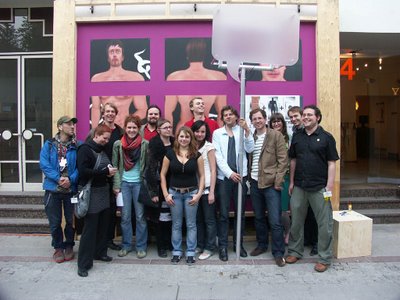
I finally managed to put together a documentation about Second City Ars Electronica 2007. The festival invited me to make a design for Marienstrasse, to show my work and to involve other artists in collaboration for the Second City all relating to metavers and Second Life.
Pics info and more on the project page.
I had a great team! Thx to everybody!
“Tree” during Ars Electronica, documentation & movie
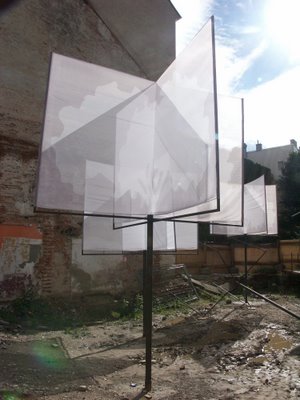
A forest, half virtual, half real, on Marienstraße, Second City, Ars Electronica 2007. As in most computer games and 3D worlds, objects from the real world are “copied” or simulated in simplified form and in accordance with programming constraints. Textures are applied to 3D structures and, depending on lighting conditions, the images making up the virtual scenery are computed in real time during the game. Most trees are constructed out of two interlocking surfaces, each of which is covered with the same tree-view texture. The transparency of the gaps between the leaves and branches is provided by a so-called alpha channel in the graphics file. From a certain distance and the corresponding perspective, this abstracted form of a tree in virtual space doesn’t stand out as a simplification.
…read on & more pics on project page
